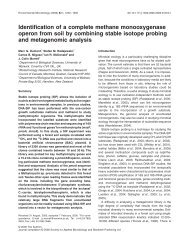Conservation of the vaquita Phocoena sinus - The Department of ...
Conservation of the vaquita Phocoena sinus - The Department of ...
Conservation of the vaquita Phocoena sinus - The Department of ...
You also want an ePaper? Increase the reach of your titles
YUMPU automatically turns print PDFs into web optimized ePapers that Google loves.
204 L. Rojas-Bracho, R. R. Reeves and A. Jaramillo-Legorreta<br />
menting <strong>the</strong> refuge, <strong>the</strong> federal Ministry <strong>of</strong> Agriculture and Fisheries and <strong>the</strong> Ministry <strong>of</strong><br />
Environment proceeded to develop <strong>the</strong> concept <strong>of</strong> a polygon covering 1263.77 km 2 . Of that<br />
area, 900.02 km 2 is inside <strong>the</strong> Reserve, representing somewhat less than 17% <strong>of</strong> <strong>the</strong> total<br />
marine surface area within <strong>the</strong> Reserve boundaries. To put it in a wider perspective, <strong>the</strong><br />
polygon as proposed by <strong>the</strong> ministries would create a <strong>vaquita</strong> refuge occupying only 0.36%<br />
<strong>of</strong> <strong>the</strong> total surface area <strong>of</strong> <strong>the</strong> Gulf <strong>of</strong> California – hardly a large area in global terms. It<br />
must be said, however, that <strong>the</strong> polygon does incorporate a very large proportion <strong>of</strong> <strong>the</strong><br />
<strong>vaquita</strong>’s known range (see below).<br />
<strong>The</strong> Programme for <strong>the</strong> Protection <strong>of</strong> Vaquita was published in <strong>the</strong> Mexican Federal<br />
Register on 29 December 2005. It called for <strong>the</strong> transfer <strong>of</strong> $1 million to <strong>the</strong> state governments<br />
<strong>of</strong> Baja California and Sonora to support implementation. Besides establishment and<br />
enforcement <strong>of</strong> <strong>the</strong> polygon, <strong>the</strong> programme addressed some o<strong>the</strong>r CIRVA recommendations,<br />
e.g. those calling for development <strong>of</strong> economically productive alternatives to gillnet<br />
fishing, alternative fishing gear and methods, and environmental education and research<br />
programmes.<br />
For <strong>the</strong> following reasons, we regard this <strong>of</strong>ficially declared programme as an important<br />
step towards <strong>vaquita</strong> conservation:<br />
• It was <strong>the</strong> first measure taken by any Minister <strong>of</strong> Environment specifically to address <strong>the</strong><br />
<strong>vaquita</strong>’s need for protection against gillnet entanglement. As explained earlier, <strong>the</strong> actual<br />
design and configuration <strong>of</strong> <strong>the</strong> Biosphere Reserve may have benefited o<strong>the</strong>r threatened<br />
species but were ill-suited to <strong>the</strong> purpose <strong>of</strong> <strong>vaquita</strong> conservation.<br />
• It explicitly acknowledged and attempted to implement recommendations <strong>of</strong> CIRVA and<br />
<strong>the</strong> Joint Initiative (a coalition <strong>of</strong> non-governmental organizations; Table 4).<br />
• It redirected <strong>the</strong> focus <strong>of</strong> concern away from trawlers and towards <strong>the</strong> artisanal gillnet fleet,<br />
which is responsible for most <strong>vaquita</strong> mortality. Previously (from <strong>the</strong> early 2000s), <strong>the</strong> emphasis<br />
on trawlers and <strong>the</strong>ir supposed role in causing <strong>vaquita</strong> by-catch had made it impossible<br />
to establish a constructive dialogue with a major part <strong>of</strong> <strong>the</strong> fishing sector. <strong>The</strong> 2005 programme<br />
identified <strong>the</strong> artisanal fleet using gill nets as <strong>the</strong> main risk factor and included<br />
potential solutions involving social and economic approaches and participation by all<br />
stakeholders.<br />
• <strong>The</strong> strategy embodied in <strong>the</strong> programme for dealing with <strong>the</strong> polygon issue avoided <strong>the</strong><br />
difficulties that would come from reopening <strong>the</strong> Biosphere Reserve Decree to negotiation.<br />
Instead, it resorted to an entirely different legal instrument: <strong>the</strong> wildlife refuge. In this way,<br />
it managed to extend protection to at least a substantial part <strong>of</strong> <strong>the</strong> 40% <strong>of</strong> <strong>the</strong> <strong>vaquita</strong><br />
population estimated to be outside <strong>the</strong> Reserve boundaries at any given time.<br />
Although it may represent progress, this 2005 programme does not represent a complete<br />
or final solution to <strong>the</strong> <strong>vaquita</strong> bycatch problem. This would be true even if <strong>the</strong> programme<br />
were implemented and enforced immediately and with 100% effectiveness. <strong>The</strong> need would<br />
still exist for fur<strong>the</strong>r bycatch reduction measures to allow <strong>the</strong> severely depleted <strong>vaquita</strong><br />
population to recover to a point where it is no longer at risk <strong>of</strong> extinction. Shortcomings <strong>of</strong><br />
<strong>the</strong> programme include <strong>the</strong> following:<br />
• Design <strong>of</strong> <strong>the</strong> polygon. Although <strong>the</strong> Ministry had agreed in 2004 and early 2005 to<br />
implement <strong>the</strong> polygon proposed by CIRVA without change, <strong>the</strong> final design failed to grasp<br />
<strong>the</strong> underlying philosophy <strong>of</strong> <strong>the</strong> survey methodology (distance sampling for density and<br />
abundance estimation). Ra<strong>the</strong>r than recognizing that survey sighting positions represent<br />
moments in time (‘snapshots’) for highly mobile creatures, <strong>the</strong> ministry’s published polygon<br />
was created simply by drawing lines to connect <strong>the</strong> sighting positions with no consideration<br />
given to encompassing a ‘buffer’ area around <strong>the</strong>m.<br />
© 2006 <strong>The</strong> Authors. Issue compilation © 2006 Mammal Society, Mammal Review, 36, 179–216




